- Clone
- MR5-2 (See other available formats)
- Regulatory Status
- RUO
- Other Names
- T cell receptor beta 8
- Isotype
- Mouse IgG2a, κ
- Ave. Rating
- Submit a Review
- Product Citations
- publications
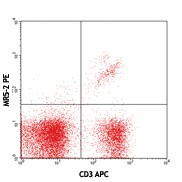
-

BALB/c splenocytes stained with MR5-2 PE and CD3 APC
| Cat # | Size | Price | Quantity Check Availability | Save | ||
|---|---|---|---|---|---|---|
| 140103 | 25 µg | 104€ | ||||
| 140104 | 100 µg | 181€ | ||||
Vβ8 T cell receptor (TCR Vβ8) subfamily has three members, Vβ8.1, 8.2, and 8.3. These subfamily members are variants of the TCR β chain that along with the TCR α chain forms the TCR heterodimer, responsible for the recognition of peptides presented by the MHC molecules. Murine Vβ8+ T cells recognize the superantigen staphylococcal enterotoxin B (SEB); in vivo administration of SEB results in the negative selection of Vβ8+ cells in the thymus. Vβ8 is one of the most frequently found β chains on the infiltrating T cells in the brain of mice with experimental autoimmune encephalomyelitis (EAE), and on the T cells response to Toxoplasma gondii.
Product DetailsProduct Details
- Verified Reactivity
- Mouse
- Antibody Type
- Monoclonal
- Host Species
- Mouse
- Immunogen
- H-Y specific TH Clone OI6
- Formulation
- Phosphate-buffered solution, pH 7.2, containing 0.09% sodium azide.
- Preparation
- The antibody was purified by affinity chromatography and conjugated with PE under optimal conditions.
- Concentration
- 0.2 mg/ml
- Storage & Handling
- The antibody solution should be stored undiluted between 2°C and 8°C, and protected from prolonged exposure to light. Do not freeze.
- Application
-
FC - Quality tested
- Recommended Usage
-
Each lot of this antibody is quality control tested by immunofluorescent staining with flow cytometric analysis. For flow cytometric staining, the suggested use of this reagent is ≤1.0 µg per million cells in 100 µl volume. It is recommended that the reagent be titrated for optimal performance for each application.
- Excitation Laser
-
Blue Laser (488 nm)
Green Laser (532 nm)/Yellow-Green Laser (561 nm)
- Application Notes
-
Additional reported applications (for the relevant formats) include: induction of proliferation of Vβ8.1+ and Vβ8.2+ T cells1,2 and immunohistochemical staining3.
- Application References
-
- Kanagawa OJ. 1988. J. Immunol. Methods 110:169. (Activ)
- Denkers EY, et al. 1986. J. Immunol. 156:1089. (Activ)
- Drescher KM, et al. 2000. Int. Immunol. 12:271. (IHC)
- Huang JR, et al. 2014. J Immunol. 192:1972. PubMed
- Product Citations
-
- RRID
-
AB_10641144 (BioLegend Cat. No. 140103)
AB_10639942 (BioLegend Cat. No. 140104)
Antigen Details
- Structure
- Members of the immunoglobulin superfamily, Vβ8.1 and 8.2 are variants of the TCR β chain which associates with the TCR α chain to form the TCR heterodimer.
- Distribution
-
Expressed in a subset of TCR αβ+ T cells
- Function
- Recognition of peptides presented in the MHC molecules, responsible for T cell mediated immune response
- Ligand/Receptor
- MHC-Peptide complex
- Cell Type
- T cells
- Biology Area
- Adaptive Immunity, Immunology
- Molecular Family
- TCRs
- Antigen References
-
1. Marrack P, et al. 2008. Annu. Rev. Immunol. 26:171.
2. Acha-Orbea H and MacDonald HR. 1995. Annu. Rev. Immunol. 13:459.
3. Sim GK and Augustin AA. 1985. Cell 42:89.
4. Mami-Chouaib F, et al. 2002. Immunol. Rev. 188:114. - Gene ID
- 21577 View all products for this Gene ID
- UniProt
- View information about TCR Vbeta8.1 8.2 on UniProt.org
Related Pages & Pathways
Pages
Related FAQs
- What type of PE do you use in your conjugates?
- We use R-PE in our conjugates.
Other Formats
View All TCR Vβ8.1, 8.2 Reagents Request Custom Conjugation| Description | Clone | Applications |
|---|---|---|
| Purified anti-mouse TCR Vβ8.1, 8.2 | MR5-2 | FC,IHC |
| PE anti-mouse TCR Vβ8.1, 8.2 | MR5-2 | FC |
Customers Also Purchased
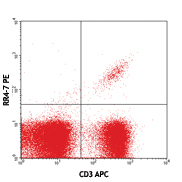
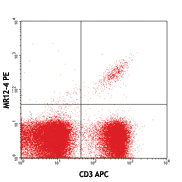
Compare Data Across All Formats
This data display is provided for general comparisons between formats.
Your actual data may vary due to variations in samples, target cells, instruments and their settings, staining conditions, and other factors.
If you need assistance with selecting the best format contact our expert technical support team.
-
Purified anti-mouse TCR Vβ8.1, 8.2
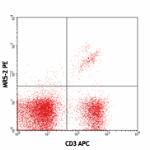
BALB/c splenocytes stained with purified MR5-2 conjugated wi... -
PE anti-mouse TCR Vβ8.1, 8.2

BALB/c splenocytes stained with MR5-2 PE and CD3 APC
 Login / Register
Login / Register 









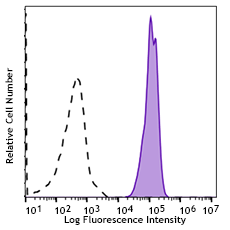
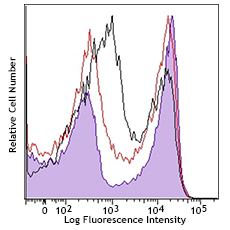



Follow Us